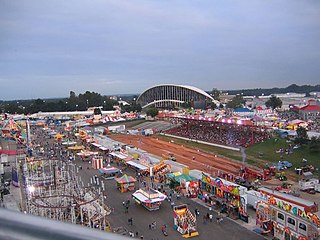
The North Carolina State Fair is an American state fair and agricultural exposition held annually in Raleigh, North Carolina. Founded in 1853, the fair is organized by the North Carolina Department of Agriculture and Consumer Services. It attracts around a million visitors over eleven days in mid-October.
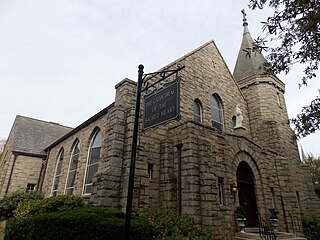
Sacred Heart Church is a Catholic church located on Hillsborough Street in downtown Raleigh, North Carolina, United States. The church served as the cathedral of the Diocese of Raleigh from 1924 to 2017. In 1978 it, and the other parish buildings, was included as a contributing property in the Capitol Area Historic District, which is listed on the National Register of Historic Places. Sacred Heart is also the location of the Cathedral School, formally called Sacred Heart Cathedral School.
Hannah's Creek Primitive Baptist Church is a historic Primitive Baptist church located at Benson, Johnston County, North Carolina. It was built about 1834 or about 1866, and is a vernacular one-story rectangular, timber-frame building, five bays wide and three bays deep. It rests on a brick pier foundation and has a gable roof. The building measures 36 feet wide and 48 feet long. The church was moved to its present location in the 1930s. Also on the property is a contributing church cemetery with burials dating from the late-19th century to 1940.

Grace A.M.E. Zion Church is a historic African Methodist Episcopal Zion church located in what was once the Brooklyn neighborhood of Charlotte, Mecklenburg County, North Carolina. It was built in 1901–1902, and is a Gothic Revival style brick church. The front facade features two crenellated entry towers of unequal height with matching Gothic arched entrances. It is one of the oldest of the remaining African American churches associated with Charlotte's historic black districts.

The U.S. Post Office and Courthouse, also known as Statesville City Hall, is a historic post office and courthouse building located at Statesville, Iredell County, North Carolina. It was designed in the Richardsonian Romanesque style by Willoughby J. Edbrooke and built in 1891. It is a rectangular 2 1/2-story structure, seven bays wide, and three bays deep. It is constructed of red brick and sandstone. The building has a two-story corner tower, one-story entrance pavilion with central arched recessed entrance, and a tall hip roof.

Richard Sharp Smith was an English-born American architect, noted for his association with George W. Vanderbilt's Biltmore Estate and Asheville, North Carolina. Smith worked for some of America's important architectural firms of the late 19th century—Richard Morris Hunt, Bradford Lee Gilbert, and Reid & Reid—before establishing his practice in Asheville. His most significant body of work is in Asheville and Western North Carolina, including dozens of buildings that are listed on the National Register of Historic Places or are contributing structures to National Register Historic Districts.

The former Auburn Post Office building is located in the City of Auburn, 20 Auburn Avenue NE at First Street NE. This is one block north Main Street, the historic business and commercial center. The main entrance is the west face on Auburn Avenue.
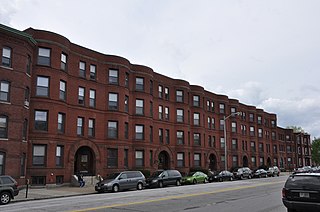
The Smith and Dow Block is a historic apartment house at 1426-70 Elm Street in Manchester, New Hampshire. When built in 1892, this four-story brick building was the largest apartment block in the state, and it still dominates its section of Elm Street. It has modest Romanesque styling elements, and was designed by William M. Butterfield, one of Manchester's leading architects, as an investment property for John Butler Smith and Frederick C. Dow. The building was listed on the National Register of Historic Places in 2002.

Intheoaks, also known as In-the-oaks, is a historic estate and a national historic district located at Black Mountain, Buncombe County, North Carolina. The district encompasses nine contributing buildings, two contributing sites, seven contributing structures, and four contributing objects associated with a country estate of the 1920s. The main house was built in 1921–1923, and is a four-level, U-shaped Tudor country manor house with an oblique wing. It was designed by New York architect Frank E. Wallis, with a large recreation wing containing a ballroom, gymnasium, bowling alley, and indoor swimming pool designed by architect Richard Sharp Smith. Also on the property are the contributing Caretaker's Cottage (1923), agricultural and service outbuildings, main entrance gates designed by Smith and Carrier (1922), and landscape designed by noted landscape architect Chauncey Beadle The property is known as Camp Henry, a camp for young people and the Episcopal Diocese of Western North Carolina offices are located on the estate.

Franklin Pierce Tate House is a historic home located at Morganton, Burke County, North Carolina. It was designed by architect Electus D. Litchfield and completed in 1928. It is a two-story, Colonial Revival style dwelling constructed of irregularly-coursed, rock-faced granite blocks.

Smith Warehouse is a historic tobacco storage warehouse located at Durham, Durham County, North Carolina. It was built in 1906, and is a two-story Romanesque-style brick structure divided into 12 70-foot-wide units by projecting corbeled firewalls. The building measures 850 feet long and 100 feet wide and features ornamental brickwork. It is an example of "slow burn" masonry and wood factory construction. It was the last of the 12 brick tobacco storage warehouses erected by The American Tobacco Company trust beginning in 1897. The building has been converted for academic and administrative uses.

Winston-Salem Southbound Railway Freight Warehouse and Office is a historic railway freight warehouse and office building located at Winston-Salem, Forsyth County, North Carolina. It was built in 1913, and is a two-story, brick railroad building with a shallow gable roof and Italianate-style design elements. It measures 40 feet by 224 feet. The building served until 1985 as headquarters for the Winston-Salem Southbound Railway. In 1990, the building was sympathetically renovated for office use.

William Penn High School, also known as High Point Normal & Industrial Institute, is a historic high school for African-American students located at High Point, Guilford County, North Carolina. The high school building was built in 1910–1911, and enlarged and renovated in 1929–1930. It is a two-story, 12 classroom Colonial Revival style brick building. It has a projecting three-bay entrance pavilion. Two other buildings associated with the High Point Normal & Industrial Institute are on the property. The Institute was established by Quakers in 1891. They were built about 1910 and are a gable end frame structure sheathed in corrugated metal with a distinctive monitor roof and a brick building with a low pitched roof. The school closed in 1968 and was re-opened in 2003 as an arts magnet high school, Penn-Griffin School for the Arts.
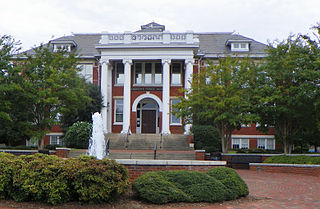
Jamestown High School, Former, also known as Jamestown Public School, is a historic school building located at Jamestown, Guilford County, North Carolina. It was designed by architect Charles E. Hartge and built in 1915. It is a 2 1/2-story, Classical Revival style brick building with cast stone detailing. It features a full-height tetrastyle entrance portico supported by Ionic order columns and pilasters. The building underwent a major rehabilitation and adaptive reuse in 1986 and 1987.
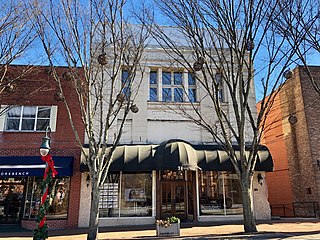
The Former Citizens Bank and Trust Company Building is a historic bank building located at Waynesville, Haywood County, North Carolina. It was built in 1921, and is a two-story, brick and marble front rectangular building in the Classical Revival style. It measures 76 feet by 31 feet and features a tall parapet faced with marble block that rises above the cornice. The bank ceased operation in 1932, and the building has since housed retail businesses.

The Waynesville Municipal Building, also known as the Former US Post Office Building, is a historic post office building located at Waynesville, Haywood County, North Carolina. Its construction in 1917 was supervised by the Office of the Supervising Architect under James A. Wetmore, and is a two-story, brick rectangular building in the Classical Revival style with a one-story rear extension. It measures 58 feet by 73 feet and features brick Ionic order pilasters with granite bases and capitals. The building housed Waynesville's post office until 1966 when it was purchased by the Town of Waynesville to serve as its Municipal Building.

Seaboard Air Line Railroad Passenger Station is a historic train station located at Charlotte, Mecklenburg County, North Carolina.

Hayes-Byrum Store and House is a historic home, store, and national historic district located near Charlotte, Mecklenburg County, North Carolina. The store was built about 1890, and is a one-story, gable front, brick building. It measures 35 feet by 60 feet and has a wide, arched entrance with wooden double doors. North of the store is the two story, asymmetrical, Queen Anne style frame dwelling built about 1900. It has a cross-gable roof and features a cutaway bay. The store is considered the oldest surviving commercial building in rural Mecklenburg County.
Royall Cotton Mill Commissary is a historic commercial building associated with the Royall Mill and located at Wake Forest, Wake County, North Carolina. It built in 1900, and is a two-story, rectangular brick building with a low gabled metal roof and stepped parapet. It measures 32 feet by 100 feet and has segmental arched windows. The Royall Cotton Mill Commissary closed in 1934. The building has been rehabilitate into apartments.

The Keweenaw Waterway Upper Entrance Light is a lighthouse located at the north end of the Portage River in McLain State Park in Hancock Township, Michigan. It was listed on the National Register of Historic Places in 2014.






















